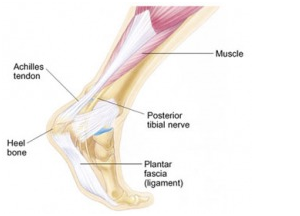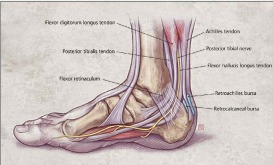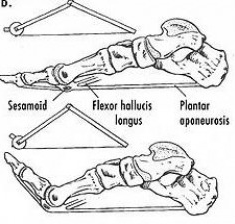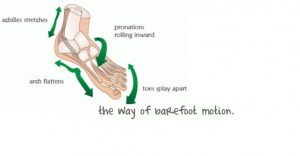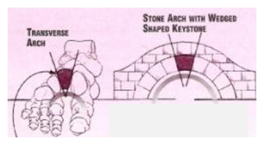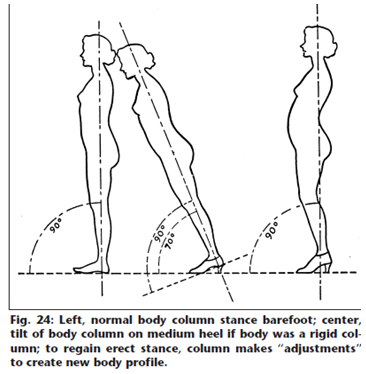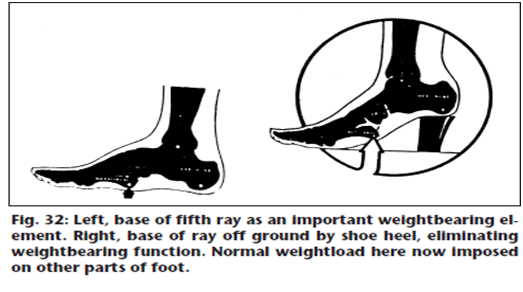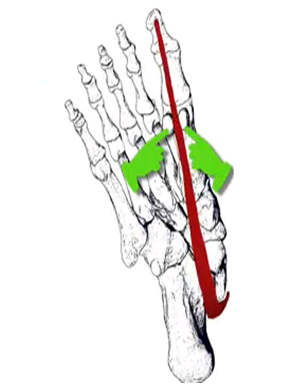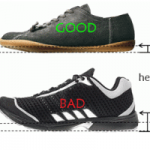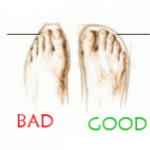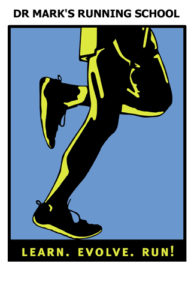 Foot Anatomy 101- the Foot is Designed to be Flat on the Ground
Foot Anatomy 101- the Foot is Designed to be Flat on the Ground
The foot is the least understood of all moving body parts because of the complex interworking between its many joints, tendons, nerves and more. What we do know is that the foot is perfectly built for its two most important functions: (1) absorbing shock and (2) propulsion. These functions are first controlled by the brain and spinal cord that receive messages from thousands of nerve endings on sole of the foot. Nerves relay vital information about the ground terrain so the body can react accordingly. When the foot’s sensing system is synchronized with its moving hardware the foot becomes an unbeatable, self-sufficient and adaptable machine.
Foot Facts
- 26 bones with 33 joints (making up one-quarter of the body’s bones)
- over 100 muscles, tendons & ligaments (site of the strongest tendon in the body)
- over 200,000 nerve endings (densest concentration in entire body)
- over 250,000 sweat glands (expel 1 pint of sweat per day)
- a network of blood vessels
- gastrocnemius (large calf muscle)
- soleus (lower calf muscle)
- quadratus plantae (sole muscles)
It is tendons that are most crucial for movement because they provide such a high amount of energy for their size, the kind of energy that can be seen by the stretching and snapping of a rubberband. The four major tendons originate below the knee and string all the way down to the foot. The later two tendons string down along the inward side of the ankle bone, wrap under the arch, and attach at the very tips of the toes.
Four Major Tendons:
- achilles tendon (strongest tendon in the body)
- posterior tibialis (supports arch)
- flexor digitorum (curls four smaller toes)
- flexor hallucis (curls big toe)
One Major Ligament:
- plantar fascia (tension from heel to ball of foot)
The foot uses the Windlass Mechanism upon landing and at push-off. The arch of the foot can imagined as a triangle. The bottom of the triangle is the all important plantar fascia ligament that serves as a high tension cable. When the toes are lifted the plantar fascia wraps around the metatarsal bones tightening its tension which lifts the foot’s arch higher and higher. The further the toes are flexed back the higher the arch rises.The raising and flattening of the arch is maybe the most important mechanism of the foot. Since the height of arch is controlled by flexing the toes, the toes play a critical role in both absorbing shock and propulsion.
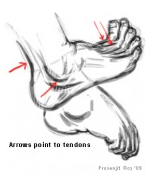 During the stride cycle as the foot comes down for a landing the toes are flexed up so that the foot lands with the arch high like a shock absorber at full extension. Then as the body bears weight on the foot, the toes lower and the arch flattens dissipating shock in a controlled manner. Into the next phase of the stride the body moves forward and the heel lifts up which again flexes the toes up lifting the arch and turning it into a rigid lever. The rigid lever makes for an energy efficient and rapid push-off. Therefore, according to the Windlass Mechanism free movement of the toes and plantar fascia ligament are critical for proper shock absorption and propulsion.
During the stride cycle as the foot comes down for a landing the toes are flexed up so that the foot lands with the arch high like a shock absorber at full extension. Then as the body bears weight on the foot, the toes lower and the arch flattens dissipating shock in a controlled manner. Into the next phase of the stride the body moves forward and the heel lifts up which again flexes the toes up lifting the arch and turning it into a rigid lever. The rigid lever makes for an energy efficient and rapid push-off. Therefore, according to the Windlass Mechanism free movement of the toes and plantar fascia ligament are critical for proper shock absorption and propulsion.The foot has evolved to be an incredibly advanced system for movement. When in its natural state (without shoes) the foot moves in the most efficient and healthy way. It rolls, stretches, expands, and grasps the ground. The foot is so self-sufficient that it only works properly without shoes. Therefore, nothing worn on the foot can improve the foot’s functions but only hinder them. For example the foot has its own built in system for absorbing shock: see the picture of the Foot’s Natural Suspension System to the right.
- NO arch support: foot’s arch needs to flatten on impact to dissipate shock.
- NO heel cushioning: heel needs to be flat & level in order to stretch achilles tendon.
- NO stability or motion control: foot uses pronation, rolling inward, to deflect shock.
- NO cramped toe box: toes splay apart upon contact softening the landing.
Foot’s Natural Suspension System
The foot is the model for an ideal shock absorber. Most shock absorbers work in one direction, the foot functions in three. The Windlass Mechanism explains the vertical movement of the arch but it doesn’t explain the other directional planes. Pronation happens in a tilting direction and in the lateral direction the transverse arch flattens and toes splay apart.
Pronation
Pronation as a term has gotten a bad rap from the running shoe industry, however, it may be the most critical of all foot functions. Pronation is the 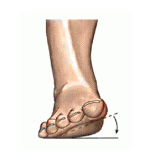 natural motion of the foot rolling or tilting inward in order to dissipate shock. It occurs at different degrees and is best seen when running or landing from a jump. The foot lands on the outside border with the ankles turned inverted. As body weight settles down on the foot, the ankles roll inward and the foot rolls inward flattening out. Pronation cannot occur with arch support, especially the support of rigid orthotics. Support simply blocks the foot from rolling inward which causes the impact force to go up the body instead of being dissipated.
natural motion of the foot rolling or tilting inward in order to dissipate shock. It occurs at different degrees and is best seen when running or landing from a jump. The foot lands on the outside border with the ankles turned inverted. As body weight settles down on the foot, the ankles roll inward and the foot rolls inward flattening out. Pronation cannot occur with arch support, especially the support of rigid orthotics. Support simply blocks the foot from rolling inward which causes the impact force to go up the body instead of being dissipated.
Transverse Arch Flattening
The ball of the foot is made of five very mobile metatarsal bones. An arch spans across these metatarsals known as the transverse arch. The foot naturally rolls across the ball of the foot starting at the outside and rolling inward to the big toe.
To initiate the roll the foot touches down on the outside at the 5th metatarsal. This 5th metatarsal is very mobile and displaces easily away from the other four metatarsals making for a soft touchdown. At this point the transverse arch begins to flatten just like a leaf spring suspension system. This flattening widens the ball of the foot by about 15%. Rarely when fitted for a shoe do you account for the extent to which the foot widens. Which is why a “snug fit” can easily result in a stress fracture of a metatarsal bone.
- Cushioning blocks feeling of the ground causing loss of nerve sensation.
- Support immobilizes the foot causing muscle atrophy.
- Support leads to a dependency.
- Even slightly elevated heels throw posture out of alignment.
- Effects of Heel Lift in Pictures- figures credit Dr. Rossi

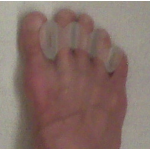 My foot without Correct Toes. Notice inward angle of large toe (hallux valgus in medical terms). My foot with Correct Toes- proper large toe alignment. With Correct Toes I immediately felt benefit in stride efficiency when the big toe was perfectly aligned. I felt my foot was the magic spring it was when I was a child running effortlessly on the beach.
My foot without Correct Toes. Notice inward angle of large toe (hallux valgus in medical terms). My foot with Correct Toes- proper large toe alignment. With Correct Toes I immediately felt benefit in stride efficiency when the big toe was perfectly aligned. I felt my foot was the magic spring it was when I was a child running effortlessly on the beach.- heel elevation: Mistakenly, almost every shoe available today has some sort of heel height, this is especially harmful in athletic shoes.
- toe spring: (sole curvature upwards) From the ball of the foot to the toes shoes curve upwards, incorrectly lifting the toes off the ground.
- tapered toebox: (narrow toe area) Nearly every shoe narrows from the ball of the foot to the toes (symmetrically), however the shape of the foot is widest at the toes and offcenter from the big toe.
- curved last: (i.e. “crooked” last) The midfoot area of the sole is cutout denying use of the 5th metatarsal ray, which is naturally a weight-bearing bone.
- Elevated heels create a “domino effect” of bones
- Shortened achilles tendons in shoe-wearing countries
- Nearly all shoes neglect the weight-bearing function of the midfoot & toes
- Lacing shoes is nothing more than “foot corseting”
- “The less a shoe does TO a foot, the better FOR the foot”
- The Myth of Support
- The Myth of Pronation
- The Myth of Ankle Support
- myth: Cushioning in a shoe absorbs shock.
- myth: In the past they didn’t have the hard surfaces of today, so we need soft cushioning & support.
- myth: Feet are fragile and need protection.
- myth: Repetitive stress activities weaken the arch over time.
- myth: Shoes prevent and decrease injuries.
- myth: I overpronate so I need a shoe to correct it.
- myth: Shoes are designed by extensive research and testing.
- myth: Children need a “good” shoe for healthy foot development.
- myth: Running shoes improve performance and absorb impact.
- myth: You want a snug fit.
- myth: I have heel pain so I need cushioning.
- myth: I need arch support for standing on hard surfaces all day.
- myth: Average life expectancy has increased, shoes are necessary to preserve the life of our feet.
- myth: Cushioning in a shoe absorbs shock.
- myth busted: Cushioning underneath the foot increases the force that you step down with. Every time the foot steps down the body tries to find its stability and so with softer material under the foot you subconsciously attempt to step through the shoe to get to a harder my stable surface. Also, cushioning blocks feeling of the type of surface beneath your feet. With cushioning the 200,000 nerve endings on the sole of the foot send false information to the brain because of the confusion for what’s actually under the foot, “is it hard or soft?”, “flat or uneven?”. The other thing about cushioning is that it’s typically combined with arch support and a snug fitting shoe, which together rob the body of its natural suspension system.
- myth: In the past they didn’t have the hard surfaces of today, so we need cushioning
- myth busted: First of all, the surfaces of today are no harder than the in the past. Some civilizations lived mainly on rocky terrain that was so uneven there wasn’t a flat enough spot to set up a bed. More importantly, the body adjusts accordingly to the hardness of the ground by landing with more knee flexion and more foot pronation. However, the more inhibiting the shoe, the less the body senses the hardness of the ground. Barefoot runners of today consider pavement one of the easiest surfaces to run on, because it’s so smooth and consistent. When you go off the road is when it gets tough.
- myth: Feet are fragile and need protection.
- myth busted: Contrary to common belief, your feet are not fragile. Most likely, they have been in shoes your entire life and you have just never given your feet a fair chance. Most of us wear flip-flops in the summer and you may have noticed by the end of the summer your feet are stronger and built-up. The feet are amazing in that they adapt to whatever you wear or don’t wear on your feet. The skin on the sole of your feet is the fastest at regenerating of all the skin on your body. This skin is 6 times stronger than all other skin tissue. Your muscles, tendons, ligaments, and bones are just as incredible at recovering and building up a tolerance. Protection in shoe design has gotten so overdone. Now we have toe bumpers, so we can carelessly go about bashing our toes. We have stiff plates in our soles, so we can mindlessly stomp our feet through the ground. And we have support and cushioning to insulate us from the world around us.
- myth: Repetitive stress activities weaken the arch over time.
- myth busted: First of all “repetitive stress” is a misleading term because what health practitioners usually mean when they use this term is “high impact exercise,” which makes up nearly all exercise. Exercise is the best thing you can do for your body. When you apply repetitive stress to any part of the body, it does fatigue but only for a short time and then it BUILDS BACK STRONGER. The arch of the foot is no exception. So when the arch is naturally exposed to repetitive stress it will get stronger which raises the arch so that next time it can better handle more repetitive stress. This is yet another case that we see the foot is a more adaptable machine than we ever thought.
- myth: Shoes prevent and decrease injuries
- Myth busted: In fact the opposite may be true. There has never been a single well done study to support the theory that more shoe is better. Strong evidence shows that thickly cushioned running shoes have done nothing to prevent injury in the 30-odd years since Nike founder Bill Bowerman invented them.
- myth: I overpronate so I need a shoe to correct it
- Myth busted: As described in our section on foot mechanics, pronation is a natural and functional movement. Overpronation is not when it is combined with weaknesses in the knee and hip…causing the runner to lose good alignment. To see extreme pronation that is completely functional watch this video of marathon world record holder Haile Gebresalasie. His foot is pronating and acting like a spring, but his core is aligned and solid. Strengthen your foot and support structure and you will run more like Geb in function, even if not in speed. If you are weak in the hips and feet- you will pronate and deform your knee angle. Watch the girl in the video, she is pronating and her knees are “kissing”.
- myth: Children need a “good” shoe for healthy foot development
- Myth busted: As Dr. Lieberman demonstrated so well in his landmark paper in Nature, footwear can influence natural gait. See Dr Lieberman’s amazing site of research. Next time you are in a park, watch a child run barefoot. Notice the relaxed movement and foot placement. They lean slightly forward and their legs fall out behind them. They do not strike hard on their heels. Then watch the child with the highly cushioned or supportive shoe. The difference is easy to see. Anything on a child’s feet should support natural neuromuscular development .Jay Dicharry and I penned a recet article in Running Times called Shoes for Small Fry
- Thin soles, allowing proper proprioception, neuromuscular activation in the entire kinetic chain, and complement the body’s natural ability to absorb ground forces.
- Low, flat to the ground profile- designed for all play activity that involves climbing, running, and jumping.
- Enhance lateral movement and not place the foot on a platform or have a slope from heel to forefoot. The materials should be soft and supple- allowing natural foot function.
- The toebox must be wide enough to allow natural toe spread.
- A single piece midsole/outsole allowing protection on unnatural surfaces (concrete, asphalt) and natural rough surfaces (rock,trail) while allowing proprioception and natural foot motion.
- A child does not need “traction” to grip. Their foot does that.
- Upper material should be soft, breathable, and washable. Yes, throw your child’s shoes in the washing machine, consider a presoak with dilute bleach, and air dry. This will reduce bacteria.
- Shoes should not be fit with thick, heavy socks- as these interfere with foot proprioception.
myth: I have heel pain so I need cushioning.
Myth busted: One of the main causes of plantar fasciitis is elevation of the heel with a more cushioned midsole. When the heel elevates the plantar fascia and Achilles shorten and becomes susceptible to injury when stressed with running activity which tends to stretch them out and stress them. Another negative effect of a cushioned elevated heel is the loss of the involuntary stretch reflex of the Achilles and posterior lower leg muscles. This stretch reflex is designed to aid the forefoot with propulsion, yet it can only be activated if the heel comes close to the ground. The elevated heels and softness of most available footwear, including athletic shoes, prevent this stretch reflex from occurring. The foot muscles and plantar fascia must activate more to make up for the loss of this stretch reflex and softer midsole materials.

